Art & Culture
While teaching in Malta in 1999, I was given the privilege of a private showing of two works of Michelangelo Merisi, better known as Caravaggio (Jerome III 1607 & John Beheaded 1608). This experience left an indelible imprint on my mind and a thirst to see and learn more of this man, his life and work. Last year while in Rome, I was drawn to the Villa Borghese to view a rare exhibit of a collection of Caravaggio's works . While visiting the Villa Borghese Exhibition of Caravaggio's masterpieces, I met a Professor Robert R. Smith from Pittsburg, PA and had the most fascinating experience in art history of my life. Oddly enough, while discussing the "Self Portrait" with Kathleen, he overheard my explanation and immediately introduced himself thinking I was an expert on this renowned artist. Little did he know that I am an avid reader of this artist and was merely reciting what I have learned from texts of Caravaggio's life. After he discovered the basis of my knowledge, he then shared with us many of the nuances in each of the nine paintings that were on display. Our common love of this Artist gave us an immediate connection for which I will forever be grateful. He had traveled the world to see Caravaggio's paintings wherever possible. He is truly a world's authority on the man and his work. Over time, I hope to present fascinating insights into Caravaggio's complex life, art masterpieces and significant influence on the art world. Enjoy the tour of some of Caravaggio's paintings and "the story behind the painting".
History
M is a person who will always be shrouded in mystery. Michelangelo Merisi, from Caravaggio, impacted the world of art during his short and troubled life. Although he was born most likely in Milan, Italy and painted there for most of his life, (1571-1610), his relationship with Malta during his last years,1608-1610, is particularly interesting. It is this relationship for which I include Caravaggio in the Malta section of this site. I have attempted to intermix information drawn from conversation, Museum personnel interpretations, scholars met at exhibits and numerous texts. The latter are available in numerous texts available at Libraries, Barnes & Noble etc. in the Art Sections for your further interest The ideas and interpretation of the art are not mine but extracted from a multitude of sources. This is meant only as an information resource on this interesting topic.
In addition, the latest and most interesting composite of Caravaggio's Malta Period has just been released, entitled " Caravaggio Knight of Malta " by Philip Farrugia Randon. One is immediately compelled to become absorbed in this superbly written manuscript by this talented author. I was honored to have spent a part of my Christmas Holiday (2004) in Malta with this amazing man and his wonderful family.
Self-Portrait as Il bacchino malato, c. 1593
Rome, Galleria Borghese
BEHIND THE PAINTING:
M is reported to have never used drawings, thus making it necessary to master the details of the human body. Aided by human subjects as models, he is known for painting everyday people into canvases as his subjects,such as the Madonna and John the Baptist. This satirical practice would later cause him problems with the Church.
M 's artistic satire is evident in this "Self- Portrait" (drawing his face from a mirror image), where he chooses to portray himself as the drunken Bacchus. His technique has been called a "lunatic frenzy" which is said to be a painter's inspiration fueled by alcohol and a lack of sleep, reflected in the pale green flesh tones of this work.
This early work belongs to a small group of self-portraits. M often mocks traditional artistic techniques, introducing the sickly and realistic tones of the skin. However, the brilliance of his talent can truly be appreciated with the use of vivid colors in detailing the fruit on the slab. In typical M style, this figure is striking, but not handsome, and presents a picture of an unhealthy person in normal life with a regal pose.
Maltese Influence
It is my purpose to present an historical chronology of the happenings of Michelangelo (heretofore to be referred to as ' M ') as they relate M's Malta Period. M was reported to be a sarcastic and haughty man. Because of his short temper, M was a raucous rebel. Argumentative people were often to be found in his company. On one such occasion, M confronted Ranuccio Tomassoni, a well- mannered young man over some disagreement about a tennis match and a dual was held. It is written that after Ranuccio fell to the ground, M struck him with the point of his sword and, having wounded him in the thigh, killed him. Everyone fled Rome, and M went to Palestrina, where he started to paint Saint Mary Magdalen of the Rosaries.
Rosary Madonna c. 1605-7
Madonna del Rosario
Kunsthhistorisches Museum, Vienna
BEHIND THE PAINTING:
M would not have agreed to paint so large an artificial subject except that he was in need of money. M appears to have delayed finishing the painting until his flight from Rome. M finally completed the painting in Naples, using a common woman of the streets as the model for the Madonna as for the London Salome. This prolonged and interrupted process might explain the anomalies of scale of the very large Virgin and the excessively tall saints. M sold the Rosary in Naples by July 1607, when he went on to Malta. M left behind from both his sojourns in Napes a body of mature religious work that determined the strong naturalistic and tenebrist orientation of Neapolitan art for much of the next half century. This legacy is said to have laid the foundation for a Neapolitan school of painting, shaping the stylistic formations of artists such as Jusepe de Ribera (1591-1652), in Naples from 1616 until his death, and of the masters of the younger generation, Matti Preti (1613-99), and Luca Giordano (1634-1705).
_______________________________
John In The Wild IV c. 1604
San Giovanni Battista
Nelson-Atkins Museum of Art, Kansas City, Missouri, Nelson Fund
BEHIND THE PAINTING :
The figure of John as a lonely pensive boy was so intriguing to M early that he painted more versions of John in the Wild than of any other figure - at least eight. This painting of John was commissioned by Ottavio Costa in 1605.It has been said that the contrasting nature of John's personality as well as M's personality can be depicted by this painting. The painting expresses a restless nature with underlying nervous energy as if ready to attach at a moment's notice. In typical M form, we see a sharp contrast between light and darkness on the figure as well as within the folds of fabric. This young man is full of vitality, but at the same time thoughtful and melancholic. Roberto Longhi believed that M intended to suggest the moon as the light source.
_______________________________
Salome II c. 1609
Salome con testa del Battista
Madrie, Palacio Real
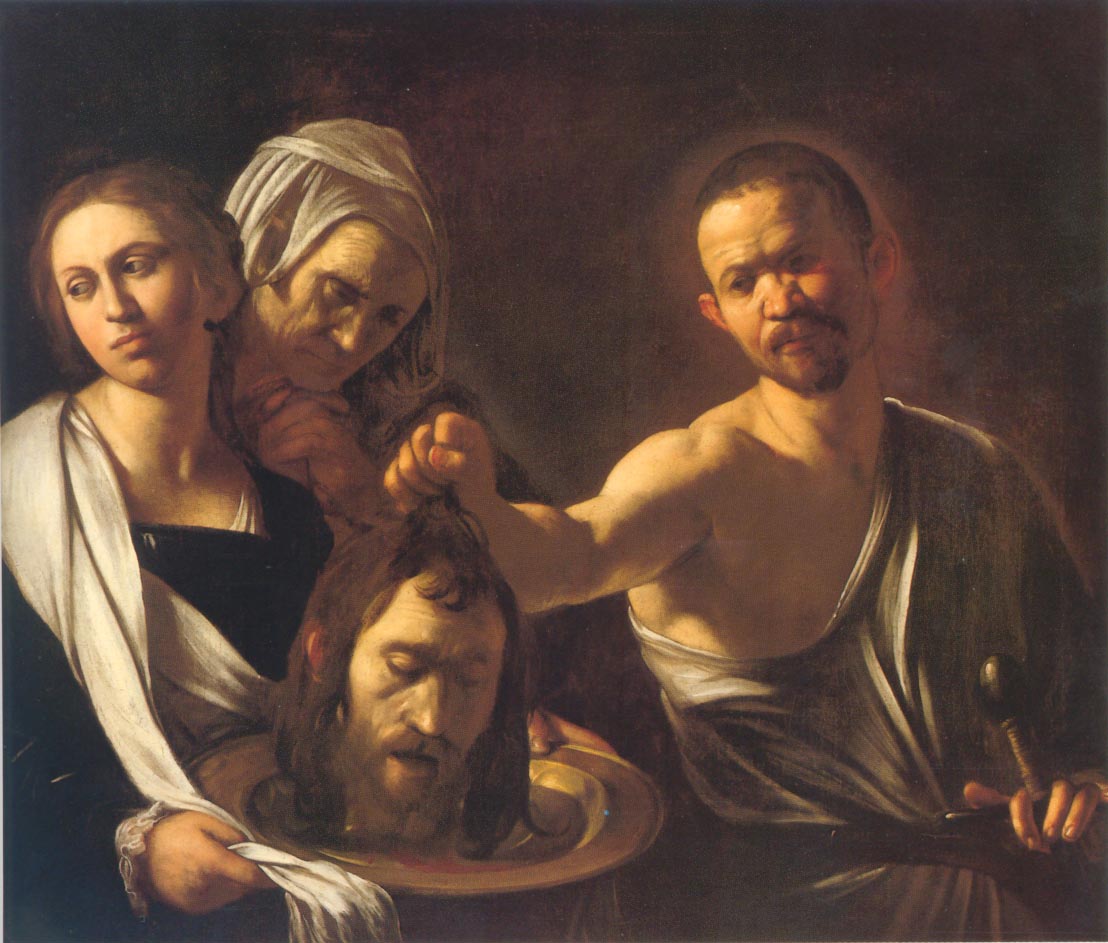
BEHIND THE PAINTING:
John the boy in the wilderness was M's favorite saint but the John that M chose to paint in Malta was the adult John who was beheaded in jail in a setup by Herod. History relates that Salome's dance and her subsequent request for John's life is a mockery of Herod's sexuality morality. This painting reminds us of the price on M's head. The painting is a paradox because Salome is nonchalant as she turns away from the head, the executioner appears detached, and the old woman clasps her hands in a sense of dismay and helpless.
The painting can be considered a souvenir of Malta, for during its history the act of beheading was quite real. In 1608, the events of the bloody Turkish siege of 1565 were still fresh in Malta's memory. The older Knights remembered the fall of their Fort Saint Elmo and the massacred knights who were decapitated, lashed to boards in the form of a cross, and floated across the Grand Canal on John's birthday, June 24. In retaliation, the Grand Master decapitated the Turkish prisoners and shot their heads from a cannon back across the water at Fort Saint Elmo.
_____________________________________________________________
The Maltese Period
On July 12, 1607, M arrived in Malta on one of the galleys of the Order of Saint John of Jerusalem. For the next fifteen months, he settled on this Mediterranean island .
Caravaggio's (M) portrait of Wignacourt, Saint Jerome , a Sleeping Cupid and the Beheading of St. John the Baptist, were painted during the distinctive Maltese Period . The Beheading of St. John the Baptist, moreover is M's largest work and the only one he seems ever to have signed.
_____________________________________________________________
Alof De Wignacourt, Grand Master of the Knights of Malta c. 1608
Ritratto di Wignacourt con paggio
Louvre, Paris
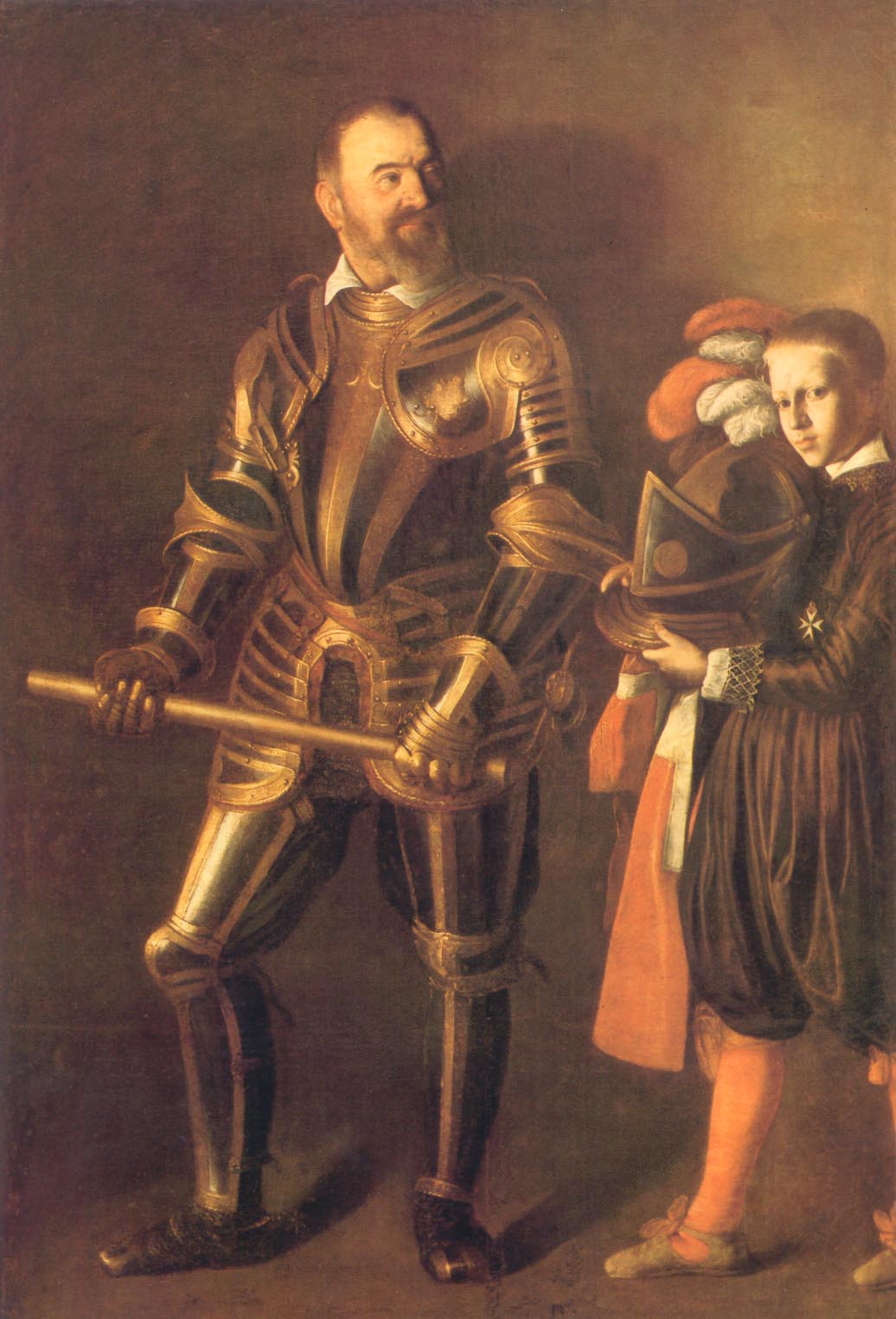
BEHIND THE PAINTING:
This painting was produced to appease the Grandmaster's desire for M's future services. "This was the best portrait M did as an inward study of an aging man of action who was also a cunning power player" As a reward or sign of merit for this portrait, M became a Knight of Malta just a year after he had arrived on the island. M loved swords and was an expert swordsman. Through his painting, he could recreate the magnificence and realism of a blade. As an individual, the blade was his downfall. In strategic battles, Malta would bring relief and victory by the sword. The Grand Master wanted M to glorify the order, and himself through his paintings. At that time, the knights had been on Malta less than a century and they needed to project their strength. When M came to Malta, he provided an artistic defining statement in " St. John.Beheaded."
Jerome III Malta c. 1607-8
San Girolamo scrivente
Co-Cathedral of St. John, La Valletta
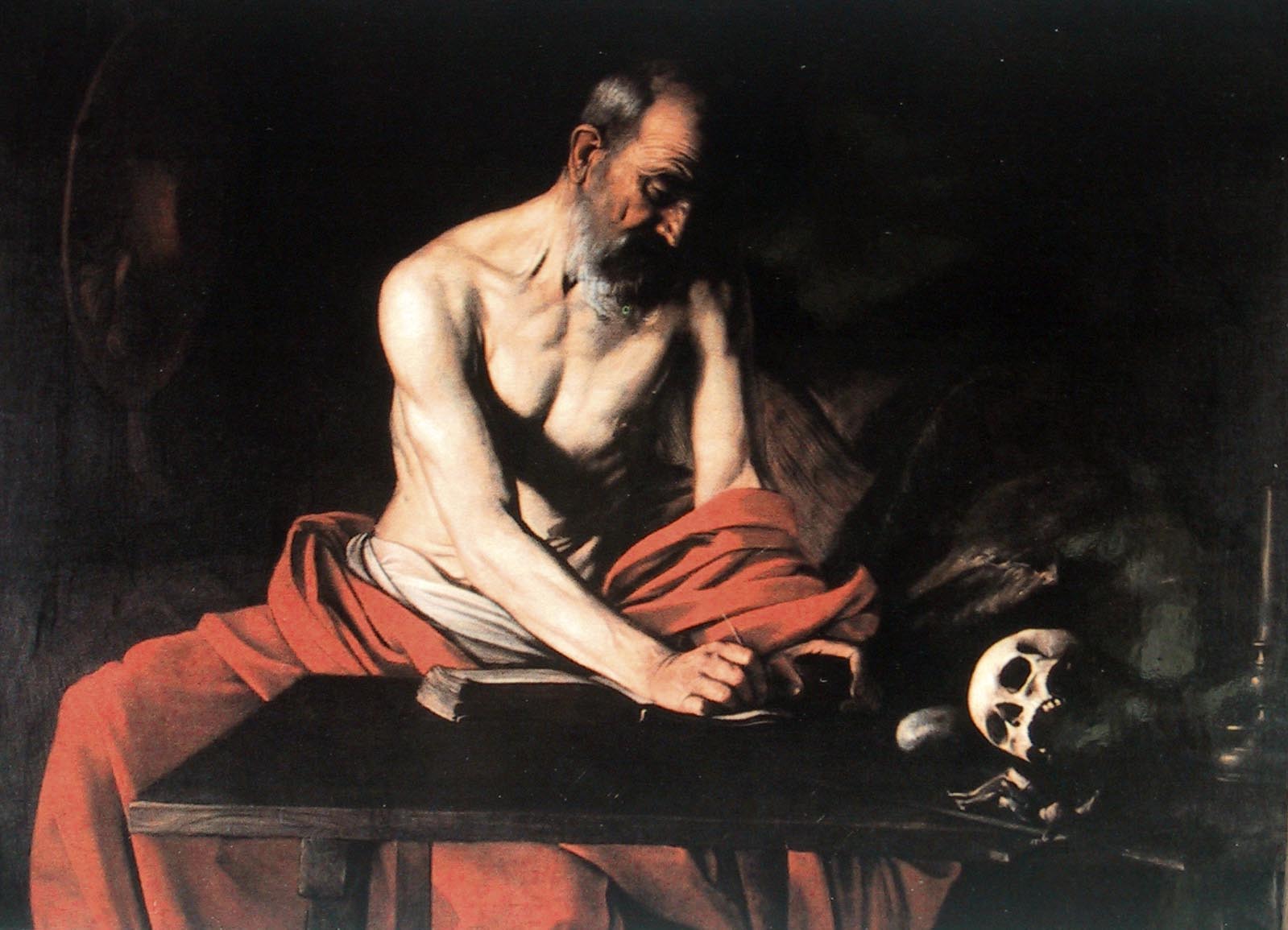
BEHIND THE PAINTING:
The painting of St. Jerome was reported to have hung in St' John's Co-Cathedral originally in the chapel of the Italian League. During the five month period from his arrival in Malta and Wignacourt's petition to the Pope in 1607 for his Knighthood, M completed this work. commissioned by Knight Malaspina. This would be a good time to get Malaspina to support his soon to be Knighthood. The painting shows the physical strength of St. Jerome and his pensiveness for battle. It also shows M's naturalism in presenting still life such as Jerome's distinctive stone and crucifix. The skull laying on its side denotes the fragile nature of material possessions. The unlit candle is the source of illumination in this painting. As has often been observed, Jerome's features resemble those recorded by M's portrait of Wignacourt. This purposeful analogy between a Doctor of the Church and the GrandMaster, a religious as well as military leader, could only serve to flatter Wignacourt and induce further favors.
Love Sleeping c.1608
Amorino dormiente
Florence, Plazzo Pitti, Galleria Paltina
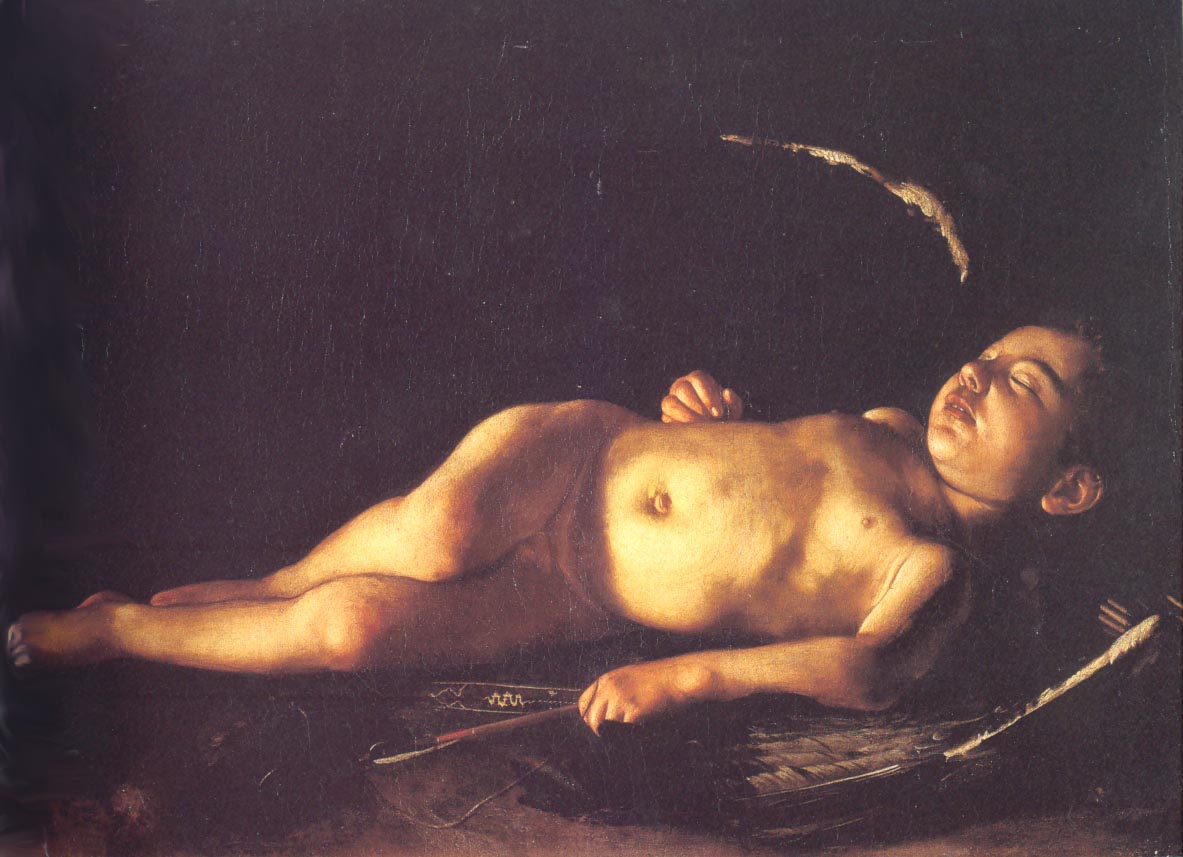
BEHIND THE PAINTING:
In comparison to the other Maltese paintings, this is considered M's most unusual work. It is also his last known mythological work. Executed in 1608, its patron was Knight Francesco dell'Antella (1567-1624) the Grand Master's Secretary of Italian Affairs who had been an advocate for M's knighthood. The work may have been painted in gratitude for this effort. The nude child looks dead instead of asleep and has quite unflattering physical features. This painting is considered by some to be an irreverent joke regarding the celibacy of the Knights of St. John.
Beheading of Saint John the Baptist c. 1608
Decollazione del Battista
Co-Cathedral of St. John, Valletta, Malta
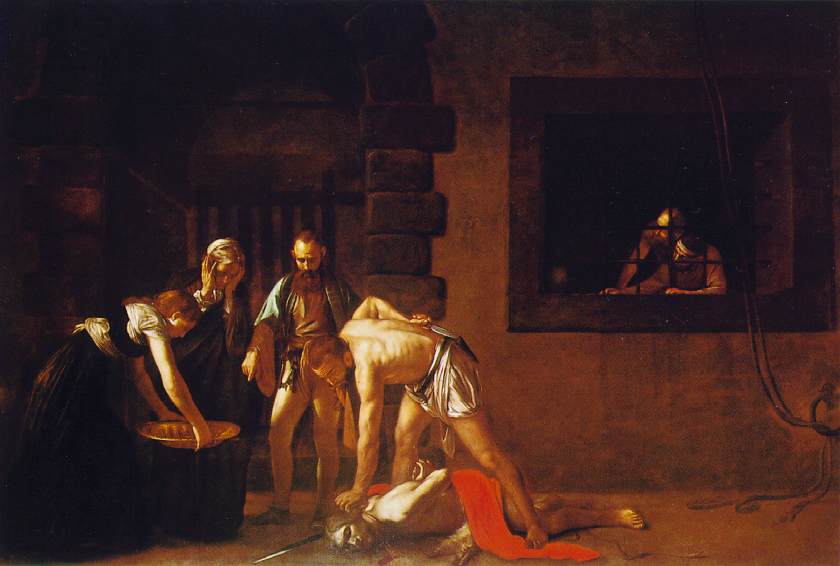
BEHIND THE PAINTING:
The Beheading of Saint John the Baptist,is decidedly the most grand of M's works. It was painted prior to the Sleeping Cupid and was probably scheduled for display on the feast of the decapitation of the Baptist, patron saint of the Knights of Malta, on 29 August 1608. Wignacourt had not only conferred the knighthood on M but also for the church of S. Giovanni he had him paint the beheading of the saint fallen to the ground. "The executioner, as though he had not quite killed him with his sword, takes a knife from his side, seizing him by the hair to cut off his head. Herodias looks on intently, and as old woman with her is horrified by the spectacle, while the prison warden, in a Turkish garment, points to the atrocious slaughter."
The story of John the Baptist is told as follows: King Herod had imprisoned John for denouncing his marriage to his brother's wife, Herodias. After his stepdaughter's dance at a banquet, Herod promised to grant her any wish. At her mother's insistence, she asked for the John The Baptist's head . The King then had John beheaded in the prison, and his head was brought on a platter and given to the girl, who brought it to her mother .
Oratory of Saint John, Co-Cathedral of St. John, Valletta
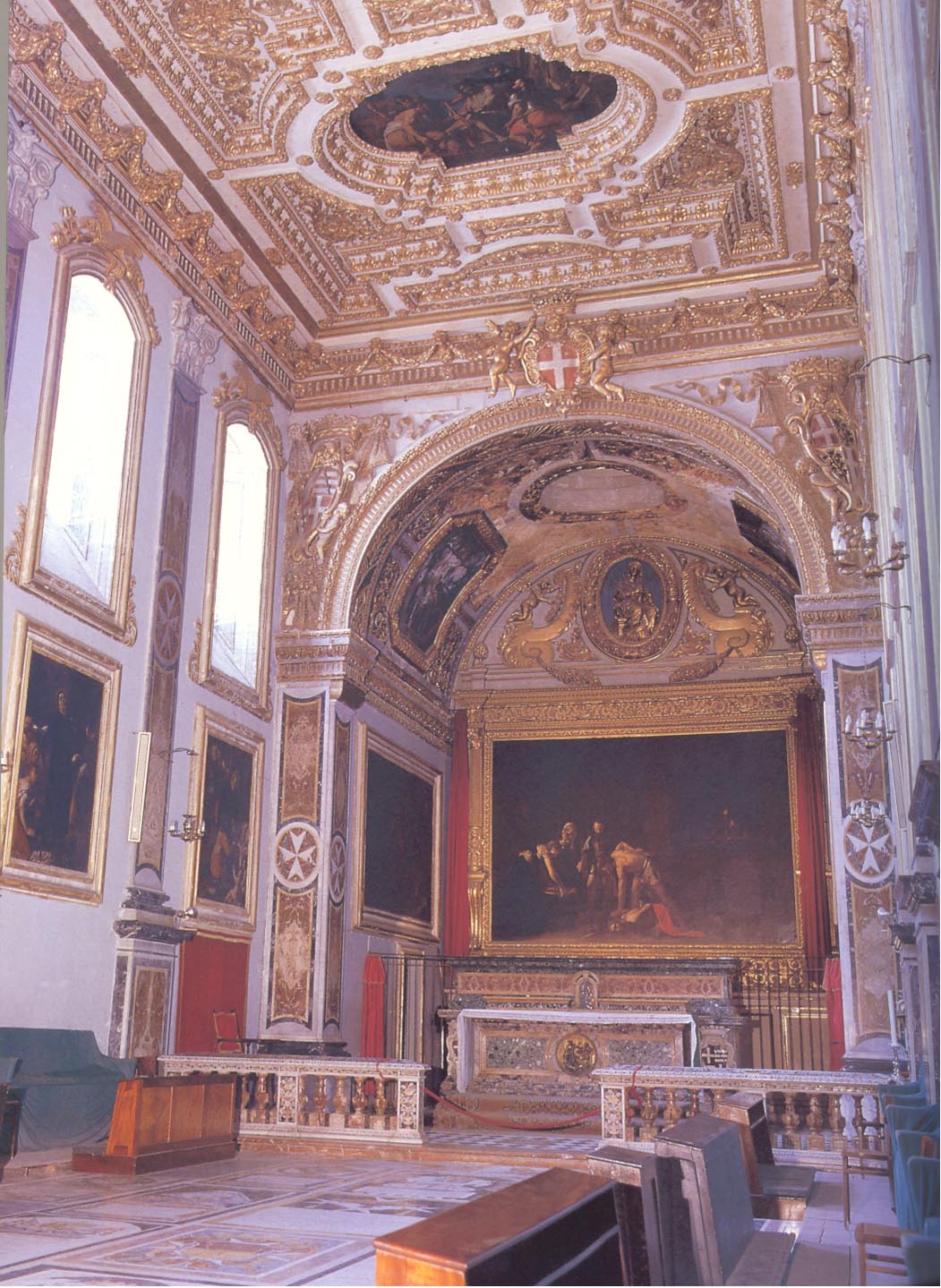
Oratory of Saint John, Co-Cathedral of St. John, Valletta
As a modern visitor to Malta, seeing the newly restored painting in St. John's Co-Cathedral was one of the most unforgettable and emotional experiences of my life. The monumental work, the largest M ever painted, decorates the altar of a large Oratory now reached by a passageway from the nave of the Co-Cathedral. This is the place where novice knights were instructed in the values and disciplines of their religion. M's timely arrival in Malta and Wignacourt's vigorous pursuit of a papal dispensation for his admission into the Order suggest that the painter's knighthood was linked to this important commission. M's acceptance of the commission may well have satisfied a requirement for knighthood for "passage money" paid by each novice upon his reception and on occasion as this made in a gesture instead of cash. This oratory of Saint John the Beheaded had been added on to the order's church of Saint John and was finished two years before M first arrived in Malta. This was built over the remains of the knights who had died in the siege and afterward. All dead knights were called martyrs. When M arrived, the Oratory was bare. Here M painted a huge canvas which was more than five meters wide and over 3 1/2 meters high, reaching across the entire width of the oratory above the simple altar.
And why did M leave Malta???
As he was wanted for murder in Rome and being sought after by the victim's wealthy and prestigious family, M was relatively safe in Malta. Here M was a Knight of the Sovereign Order of Saint John. Let me explore with you through M's paintings a possible explanation. The background details of this search were stimulated by Professor Smith of Pittsburgh ,my guide, through the Villa Borghese's exhibit of eleven of M's Paintings (a must stop when in Rome).
David II Rome 1606
Davide con testa di Golia
Rome, Galleria Borghese
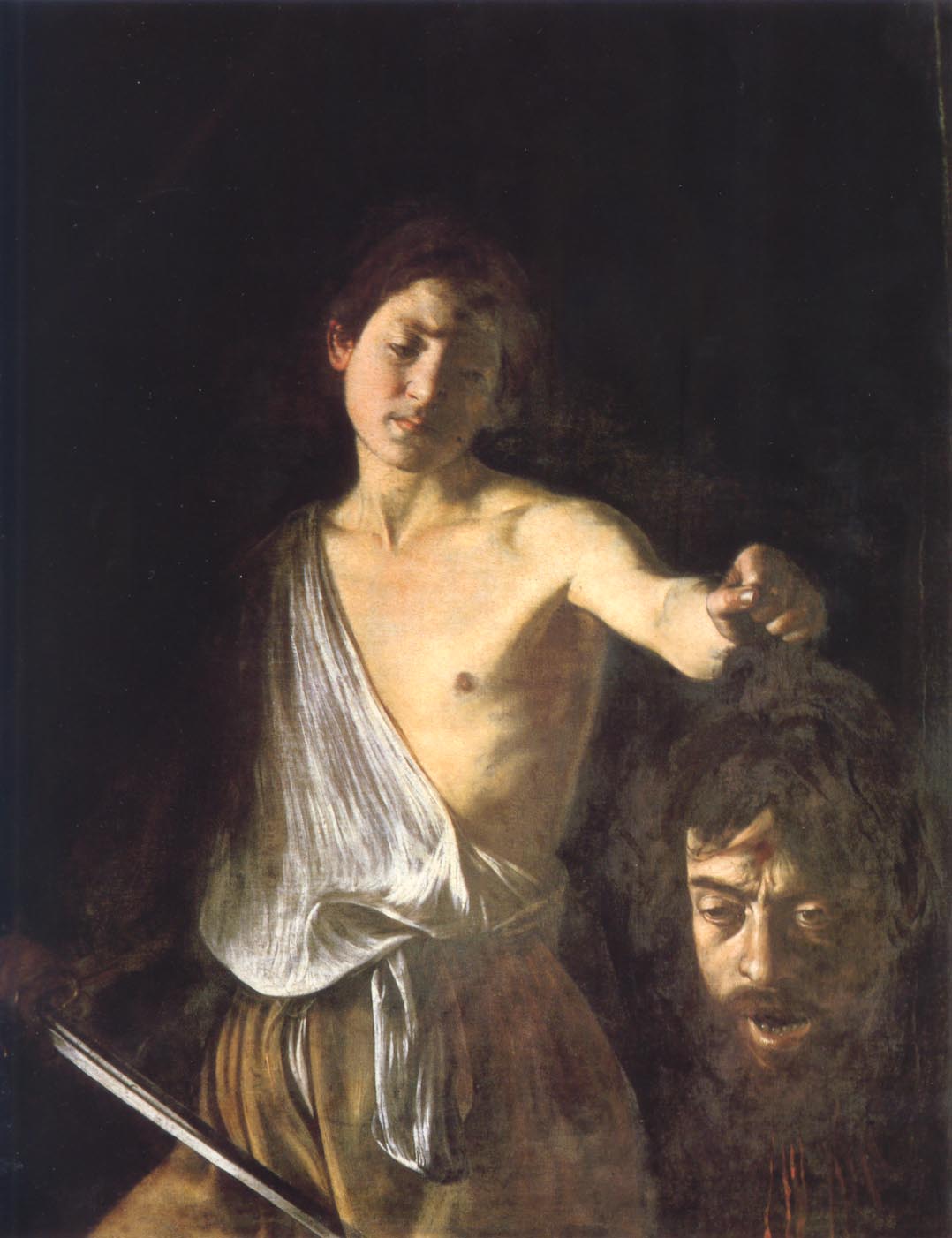
BEHIND THE PAINTING:
In this most remarkable painting of David, M painted his own wanted poster. A disconcerting work, it depicts the triumph of righteousness over arrogance, with an underlying element of sorrow. The boy (his boy lover Cecco in real life) and Goliath's head are almost lost in total darkness. An unusual interpretation, Goliath's head looks human in death, his left eye still reflecting life and mouth open for a final breath.. This appears to reveal M has half dead with a glimmer of hope that he could get a dispensation and return to his beloved Rome without the finality of jail and likely execution. It appears this painting was done in 1606 long before the final days of 1610.
COMMENT:
M's position of special dispensation in Malta came to an end, while records to not reveal exactly what brought about his punishment. History tells us that on July 14th ,M was inducted, by virtue of special interventions of the Grand Master and the Pope himself, as a Knight of the oldest and most exclusive aristocratic warrior caste in Europe. But by the first days in October, he was imprisoned in a hole in the ground called "the guva." inside the huge complex of fort Sant' Angelo that rose directly above the Grand Harbor of Valletta. The guva was a prison for errant Knights of Saint John, a prison you could leave only if someone brought you a ladder or a rope, and prisoners normally left the guva for there place of execution. By October 6, somehow, M had gotten out of the guva, escaped from the fort and fled Malta. The criminal commission of the order that day recorded the information of M's detention and his secret escape which was an amazing feat. Almost impossible without outside aid. Whatever M had done, it wasn't something the order of Saint John could bring itself to record in their copious and carefully kept records. It was written that M was formally and publicly stripped of his so eagerly sought Knighthood before the year's end and summarily removed and thrown out of our order and our community as a foul and rotten limb. The offense was so severe that the Order saw fit to avoid any mention of the charges or deed itself likely masking something personal and unspeakable. The kind of offence only a death sentence could settle. This now left M as a truly hunted man from all sides.
In his final days, M traveled to Palo and was killed on a deserted beach, the details of which have several possible suspicions. The exact details of this most talented and disturbed icon of the painting world remain speculation. M's life was somewhat clouded in turmoil but his death was a tragic loss to the artistic community.
COME BACK SOON